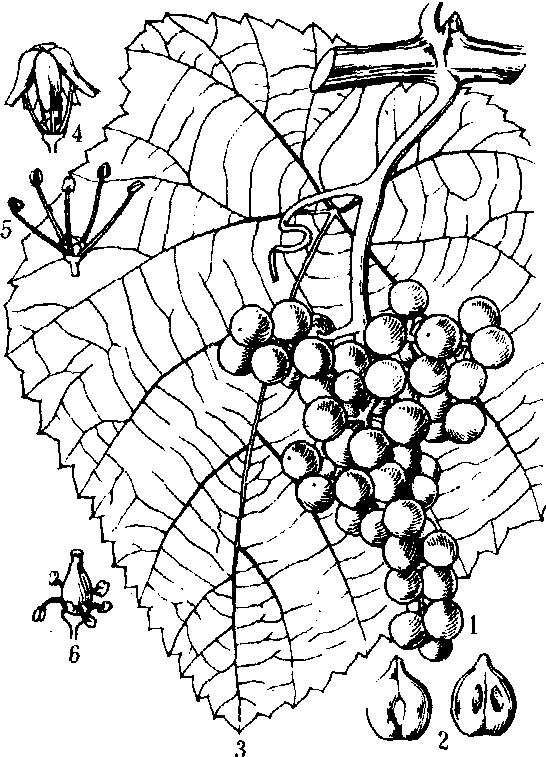葡萄种质资源V.thunbergii Sieb.et Zucc.
具有一定的遗传物质,在葡萄生产和育种上有利用价值植物的总称。葡萄是最古老的显花植物之一。第四纪冰川期前, 地面气候温暖, 葡萄属的很多种曾广泛分布在欧洲、亚洲北部和北美的格陵兰岛一带。冰川期后, 由于气温变冷和大陆变迁, 很多种因不适应新的环境条件而消亡, 葡萄属原来的分布区发生了变动。现存的葡萄植物主要分布于以下3个地区:❶高加索和里海、黑海沿岸地区;
❷东亚地区;
❸北美洲。
葡萄的种类 葡萄属有70余种, 分2亚属。
圆叶葡萄亚属(Muscadinia) 分布美国东南部和墨西哥亚热带地区,有3个种, 染色体数均为2n=40,圆叶葡萄 (Vitis rotundifolia Michaux)、乌葡萄(V.munsoniana Simpson) 和波葡萄 (V. popenoiFennell)。易相互杂交并产生发育正常的后代。果穗小,果粒少。果实多肉, 少汁, 含糖量低, 可鲜食, 不宜酿酒。扦插不易生根, 与欧洲葡萄嫁接不易成活, 故用压条繁殖。由于圆叶葡萄对葡萄根瘤蚜、线虫、霜霉病有免疫性, 所以, 长期以来育种家力图与欧洲葡萄杂交, 以培育抗根瘤蚜的葡萄新品种。但由于性的隔离, 难以获得杂交种子或发育正常的杂种。目前虽已得到了圆叶葡萄与欧洲葡萄能育的杂种, 但仍未得到有经济价值的株系。
真葡萄亚属(Euvitis) 约有70种, 染色体数2n=38, 亚属内种间杂交容易。按照地理起源分为3个种群: ❶北美种群。起源美国和加拿大东部,有28种,包括美洲葡萄(Vitis labrusca L.)、河岸葡萄(V.ripa-ria Michaux)、沙地葡萄(V.rupestris Scheele)、冬葡萄(V. berlandieri Planch. )、夏葡萄(V.aestivalisMichaux)、林氏葡萄(V.lincecumii Buckley)、山平葡萄(V. champini Planch.)、甜冬葡萄(V. cineraEngel.)、霜葡萄(V.cordifolia Michaux) 等。因原产地气候寒冷, 又是葡萄根瘤蚜和一些真菌病害的发源地, 故本种群的一些种具有多抗性特性。
❷东亚种群。起源中国、苏联远东、朝鲜、日本、越南、印度和印度尼西亚等地。有40余种,其中起源中国的最多,有27种, 如山葡萄(V.amurensis Rupr.)(见图)、蘡薁、紫葛 (V.coigne-tiae Pull.)、复叶葡萄(V.piasezkii Maxim.)、秋葡萄(V.romanetii Roman.)、毛葡萄(V. quinquangula-ris Rehd. )、华东葡萄 (V. pseudoreticulata W. T.Wang.)、华北葡萄(V. bryoniifolia Bge.). 刺葡萄(V. davidii Foex.)、葛藟(V. flexuosa Thunb.)、网脉葡萄(V. wilsonae Veitch.)、菱叶葡萄(V. hancoc-kii Hance)等。本种群分布在寒温带至热带的不同地理气候区, 不论在形态特征、经济性状或生物学性状方面, 种间往往有极大差异。
❸欧亚种群。起源于欧洲、亚洲西部和北非, 有2种, 即野生种森林葡萄和栽培种欧洲葡萄(V. vinifera L.)。后者是由前者经过自然和人工选择进化来的。

山 葡 萄
1. 果穗; 2. 种子; 3. 叶片; 4. 雄花5. 雄花花瓣脱落; 6. 两性花
葡萄的栽培种 生产上栽培的葡萄品种, 按照其亲缘关系可分为以下几类:
欧洲种 葡萄属中产量最高、品质最好、用途最广, 因而也是栽培最多的一个种。但抗寒、抗病力弱,也不抗根瘤蚜。按起源地不同,欧洲种可分为3个地理生态群: ❶东方品种群(Proles orientalis Negr. )。原产中亚细亚、高加索、阿富汗、伊朗和近东各国。叶光滑, 背面无毛或仅有刺毛。果穗大, 松散, 多呈分枝形。果肉多肉质或脆质, 无香味。果枝率低, 每果枝通常仅有1穗。树势旺, 生长期长, 抗寒性弱, 少数品种有较强的抗旱性, 抗盐碱性和对沙漠热风有较强的适应性, 适于在雨量少、气候干燥、日照充足、有灌溉条件的地区栽培和棚架整形与长梢修剪。本群绝大多数品种适于鲜食或制干, 主要品种有无核白、无核黑、牛奶(马奶子)、可口甘(Катта-Курган)、粉红太妃(Тайфи Розовый)、尼木兰(Нимранг)等。中国的龙眼、瓶儿和田红葡萄、喀什喀尔、白木拉格等,也属于本品种群。
❷黑海品种群 (Proles ponticaNegr.)。原产黑海沿岸和巴尔干半岛各国。果穗多紧密,树势中庸或旺盛,抗寒性较强。多数品种适于酿酒,如白羽(Ркащителй)、晚红蜜(Саперави)、富明特(Fur-mint); 少数适于鲜食, 如花叶白鸡心(Tchaouche)等。
❸西欧品种群(Vitis occidentalis Negr.)。原产法国、意大利、西班牙、奥地利等国。叶背有绒毛;果穗小, 紧密, 果肉多汁。树势中庸, 生长期短, 较抗寒。果枝率高, 果穗多, 产量中等或较高。多数品种适于酿酒, 如雷司令 (White Riesling) 、黑比诺(Pinot Noir)、赤霞珠(Cabernet Sauvignon)、白诗南(Chenin Blanc)、贵人香(Italia Riesling)等;少数供鲜食,如意大利(Italia)、皇帝(Imperior)、雷比尔(Ribier)等。
美洲种杂种 美洲种自由授粉或种间杂交获得的品种, 少数供食用, 多数为砧木。康可(Concord)是美国纽约州、华盛顿州、密执安州的主要栽培品种, 可鲜食、酿酒和制汁, 抗寒、抗病、丰产, 果实常具极浓的草莓香味, 鲜食和酿酒品质差。
欧美杂种 美洲种或其杂种与欧洲种的杂交品种。鲜食及酿酒品质虽比欧洲葡萄差, 但抗病、抗湿、抗寒力强, 如康拜尔早生 (Campbell Early)、玫瑰露(Delaware)、巨峰、白香蕉等。法国的黑巴可(BacoNoire)、赛必尔(Seibel)等, 也是欧美杂种。
欧山杂种 中国、苏联等国家栽植一定面积的欧洲葡萄与山葡萄的杂交品种。这些品种丰产、抗寒、抗病力强, 但鲜食和酿酒品质不如欧洲葡萄。
主要野生种特性
美洲葡萄 原产美国东部, 叶背密生纯毛。卷须连续性。果粒中等大, 皮厚, 有肉囊, 具特殊的狐臭味或草莓香味。能耐冬季-30℃低温, 抗真菌病害能力强。可作抗寒、抗病育种的亲本。
河岸葡萄 原产美国西、南部。叶光滑, 锯齿尖锐。能耐冬季-30℃低温, 抗根瘤蚜、霜霉病和白粉病能力极强。扦插生根容易。可用作欧洲葡萄的抗根瘤蚜砧木和抗根瘤蚜砧木育种的重要亲本。
沙地葡萄 原产美国中、南部。叶广心脏形, 全缘, 光滑无绒毛。扦插生根容易, 抗寒、抗旱力强,极抗根瘤蚜, 亦抗白粉病和霜霉病。主要 作抗根瘤蚜砧木的育种亲本。
冬葡萄 原产美国南部及墨西哥。叶广心脏形。对根瘤蚜、白粉病、霜霉病有极强的抗性, 但抗寒性较差, 扦插生根困难, 是选育抗根瘤蚜和耐石灰质土壤砧木的优良种质。
山葡萄 中国东北、苏联远东、朝鲜、日本有分布,是葡萄属中抗寒性最强的种,枝条可耐-40~-50℃,根系可耐-15℃左右。较丰产。果实含糖量低 (10~15%), 含酸量高(2~3%), 可酿造优质山葡萄型酒。已从自然变异株系中选出两性花双庆山葡萄品种和一些优良的雌能花类型。
蘡薁葡萄 亦称董氏葡萄, 原产中国、朝鲜及日本。丰产性强, 抗寒。果实成熟时易落粒, 扦插生根容易。可作丰产、抗寒育种亲本。
刺葡萄 中国秦岭及南方一些省 (自治区) 有分布。新梢和枝条密生坚硬皮刺。果粒中等大, 叶片较抗霜霉病, 果实抗白腐病能力强。扦插生根困难。从本种的自然变异中, 已选出两性花品种塘尾葡萄。
毛葡萄 中国秦岭、泰山及其以南的许多省(自治区)有分布。叶背面及一年生枝条密生白色绒毛。花期极晚,果实成熟亦极晚。一个果枝最多生有6个果穗,较丰产。酒质醇厚,抗氧化能力强。叶片易感霜霉病,有的株系较抗白腐病。扦插不生根。已发现宝贵的白果实株系。
华东葡萄 枝条具棱。果穗小, 较紧密, 叶片抗霜霉病的能力极强。秦岭及其以南诸省有分布, 可用作抗霜霉病育种的亲本。
秋葡萄 树势旺。叶大, 全缘。一年生枝和叶柄密生腺毛。萌芽期和开花期极早。坐果率低。果实含糖量可达18~19%。
研究进展 对葡萄种质资源, 特别是野生种的研究始于17世纪。美洲大陆发现后, 欧洲移民力图将欧洲葡萄引种到北美东部栽培, 但由于这里冬季气候寒冷, 又有根瘤蚜和霜霉病的严重为害而失败。于是人们开始研究利用当地原产的野生种葡萄, 卡托巴(Ca-tawba)即是1819年采集当地葡萄枝条繁殖而成的品种。1843年伊佛莱姆(Ephraim W.Bull)播种野生种的天然授粉种子, 1849年结果, 选出实生种取名康可。同年, 野生种实生品种玫瑰露也问世。为了获得抗逆性强、品质好的品种, 美国人选用当地野生种或其自然杂种与欧洲葡萄杂交,相继培育出一批欧美杂交品种,如蜜尔紫(Mills)、康拜尔早生等。20世纪以来, 日本也培育出一批欧美杂交品种, 以适应日本国的湿润气候。
19世纪中叶, 葡萄根瘤蚜由美国传入西欧, 给欧洲、特别是法国葡萄生产带来了毁灭性灾害。法国的葡萄育种家除利用美国抗根瘤蚜的野生种作欧洲葡萄的砧木外, 还利用这些种与欧洲酿酒良种杂交, 希望育成既抗根瘤蚜,又能酿出优质酒的直接生产杂种。巴可、赛必尔就是按这样的育种目标培育出来的品种,它们曾在欧洲根瘤蚜发生地区发挥了一定作用, 但由于这些品种的酒质低劣而逐渐被淘汰。
20世纪后, 人们发现山葡萄不仅具有极强的抗寒性, 而且欧山杂种的果实品质还优于欧美杂种, 因此许多葡萄育种工作者希望以欧洲葡萄与山葡萄的杂交,育出抗寒、优质葡萄新品种, 苏联学者已培育出一批优质、多抗性的欧山杂交品种。从20世纪50年代起,中国对山葡萄的研究利用也作了大量工作, 选出了两性花品种双庆, 并用玫瑰香与山葡萄杂交,培育出抗寒、丰产的北醇、公酿1号、公酿2号等品种。中国农业科学院特产研究所还用双庆与山葡萄不同株系进行种内杂交, 获得了一批大穗、丰产的两性花单株。中国是葡萄属野生种最重要的起源地之一。因此,收集、研究和利用这些种质资源已引起国内专家的重视, 现已发现了两性花刺葡萄和白果实的毛葡萄。中国在收集、研究葡萄属种质资源方面作了不少工作, 在中国农业科学院郑州果树研究所和山西省果树研究所都建立了国家葡萄种质资源圃,收集葡萄种质资源900多份。已筛选出一批抗霜霉病、黑痘病、白腐病和炭疽病的种和株系, 同时还筛选出一种燕山葡萄, 是仅次于山葡萄的一个抗寒性强的种。